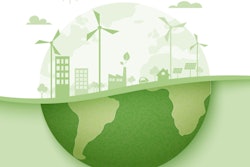
Traveling to exotic locations for educational and business conferences can be a nice perk in any industry. But what's the environmental cost of such travel? An analysis presented at this week's International Society for Magnetic Resonance in Medicine (ISMRM) meeting found that it can be significant.
In fact, the carbon footprint for ISMRM 2020 would have been much larger had the group's annual meeting taken place in Sydney, Australia, as originally planned, rather than virtually, as is the case with this week's meeting. ISMRM 2020 was shifted to an online format due to concerns about the COVID-19 pandemic.
As concerns about the environment grow, many conference organizers have been looking for ways to reduce their carbon impact, and radiology is no exception. Both the RSNA and European Congress of Radiology have moved to reduce waste and encourage recycling onsite.
The carbon emissions involved in air travel have also emerged as a concern. For example, an article published in February 2020 in the European Journal of Radiology suggested that RSNA find ways to reduce and offset the carbon footprint of its annual meeting.
With respect to ISMRM, Australia would have been an environmentally suboptimal location for the annual meeting, as measured by calculations of carbon dioxide (CO2) emissions, according to Christof Böhm of Technical University of Munich in Germany.
"Climate change is one of the defining issues of our time," said Böhm, noting that CO2 is the most abundant greenhouse gas and that CO2 is largely the product of burning fossil fuels.
Böhm and co-investigators reviewed ISMRM abstracts for 2010 through 2019, with the exception of 2011, in order to estimate the CO2 pollution linked to travel of presenters to and from meeting locations. They also hoped to generate evidence to influence future selection of ISMRM conference locations based on environmental considerations.
For each conference, Böhm and his team noted the affiliation of presenters and their locations and calculated the beeline distance they would have traveled, making the assumption that distances that exceeded 300 miles were traveled by plane.
They assumed a CO2 emission intensity of 0.34 kg per traveled mile. Based on 2019 data, they predicted a forecast for ISMRM 2020 if it had been held in Australia this year. The researchers differentiated between "actually produced" CO2 and "effective" CO2, noting that the greenhouse effect of CO2 emitted at altitudes that planes reach is on average twice as strong as at sea level.
The investigators found that first authors traveled between 27.28 million and 80.54 million miles annually for ISMRM in past years. Their travel resulted in effective CO2 emissions of between 18,526 and 54,698 metric tons. If ISMRM 2020 had taken place in Sydney as planned, travel to the show would have generated 58,288 metric tons of CO2 -- the greatest amount of any ISMRM meeting covered by the analysis.
| Total CO2 produced by travel to ISMRM annual meetings | ||
| Year | Location | Effective CO2 produced (in metric tons) |
| 2020 | Sydney | 58,288* |
| 2019 | Montreal | 23,396 |
| 2018 | Paris | 25,588 |
| 2017 | Honolulu | 42,338 |
| 2016 | Singapore | 40,780 |
| 2015 | Toronto | 18,526 |
| 2014 | Milan | 22,966 |
| 2013 | Salt Lake City | 21,082 |
| 2012 | Melbourne, Australia | 54,698 |
| 2011 | No data | No data** |
| 2010 | Stockholm | 22,242 |
**Investigators did not include data from 2011 due to archive inconsistencies.
"We concluded that locations in Europe and North America led to the smallest amount of greenhouse gas emissions," said Böhm, noting about 30 million miles were traveled by first authors attending the society's annual meeting when the annual ISMRM meetings were held in Europe or North America.
When the society meeting was held in Melbourne, Australia, in 2012, it resulted in a large increase in miles and CO2 pollution. Other locations, such as Honolulu and Singapore, also produced spikes in total traveled miles (60 million miles) compared with destinations in Europe or North America.
Investigators found that the most environmentally optimal location for an ISMRM conference would be Reykjavik, Iceland, based on analysis of 2019 data, Böhm said.
Böhm noted that only about 1% to 2% of attendees travel from Australia to ISMRM annually.
"The selection of remote locations seems unfounded," Böhm said.
Environmentally optimal locations such as in Europe and North America, which would minimize total miles traveled, could lead to a reduction of about 40,000 metric tons of CO2 per year, explained Böhm.
"We encourage the introduction of environmental considerations for conference location selection into ISMRM's constitution," Böhm said.
This year's online ISMRM 2020 conference is an illustration of the carbon offsets that could be achieved, Böhm noted.
"About 60,000 [metric tons] of CO2 have been saved this year by having an online conference," Böhm said.
It's not easy being green
But it is very unlikely that ISMRM will change its constitutional bylaws to include environmental considerations for conference location selection, said ISMRM President Lawrence Wald, PhD, of Massachusetts General Hospital.
For its part, the board of trustees of ISMRM appointed a sustainability adjunct committee to combat the carbon footprint associated with holding the annual ISMRM conference, according to Wald. Moreover, the ISMRM's board of trustees passed a resolution last year that it would attempt to reduce the carbon footprint of the annual meeting.
Wald noted that about 1,000 attendees from Australia were expected to attend ISMRM 2020 in Sydney, with many of those attendees not being first authors on papers. He said that while having the meeting in Iceland might result in the lowest carbon footprint, it's not practical to have the conference there every year.
"We are an international society and have to represent our international community," Wald said, stressing a diversity of locations for conferences reflects the international flavor of the society. "We have to spread it around."
The ISMRM has taken steps to be green in its meeting planning, eliminating the paper program and conference bags and encouraging carbon offsets to reduce the environmental impacts of flights.
"Offsetting the carbon is part of the cost of doing business," Wald said. "That does mean flying to a location like Australia is more expensive."
This year's virtual meeting has demonstrated the feasibility of holding a virtual conference, and the future may see ISMRM organize more virtual content and workshops. But the ISMRM plans to hold its annual meeting in Vancouver, Canada, in 2021.
"We are very much looking forward to having the meeting in Vancouver next year," Wald said.


.fFmgij6Hin.png?auto=compress%2Cformat&fit=crop&h=100&q=70&w=100)





.fFmgij6Hin.png?auto=compress%2Cformat&fit=crop&h=167&q=70&w=250)











